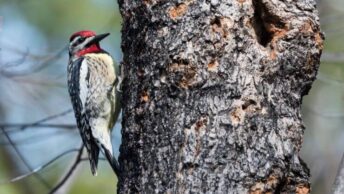Ohio is home to an incredible variety of birds that bring color and life to neighborhoods, parks, and countryside all year long. From the bright red Northern Cardinal to the bold calls of the Blue Jay, these familiar species are part of what makes Ohio’s natural spaces so vibrant. Whether you’re an experienced birdwatcher or just someone who enjoys seeing a robin hop across the lawn, it’s easy to appreciate the diversity around you.
Many of these birds stay in Ohio through every season, while others migrate and return with the warmer months. Learning to recognize their songs, habits, and appearances can make even a short walk outside feel more connected to nature. In this article, we’ll introduce you to some of the most common birds you’re likely to spot in Ohio, and share a few tips to help you enjoy and support them in your own backyard.
1. Northern Cardinal
- Scientific name: Cardinalis cardinalis
- Life span: 3–15 years
- Size: 21–23 cm / 8.3–9.1 in
- Weight: 42–48 g / 1.5–1.7 oz
- Wingspan: 25–31 cm / 9.8–12.2 in
- IUCN Status: Least Concern
- State status: Breeding and common
- Migration pattern: Stays year-round; does not leave Ohio.
The Northern Cardinal is a familiar sight across much of the eastern and central United States, stretching from southern Canada down into Mexico and parts of Central America. Male cardinals stand out with brilliant red feathers and a striking black mask around the face.
Females have warm brown plumage with hints of red on the wings and tail. Both sexes sport a tall, pointed crest and a thick, reddish bill. Cardinals stay year-round, brightening winter landscapes with their color and clear whistling calls.

Northern Cardinals build their nests low in dense shrubs or small trees, usually between three and ten feet above the ground. The female does most of the work, weaving twigs, grass, and bits of bark into a tidy, cup-shaped nest. She lines it with softer material like rootlets and hair. The male often stays close, singing to defend their little territory. Cardinals typically raise two or three broods each season, and both parents help feed the chicks.
Cardinals eat a wide mix of seeds, fruits, and insects, which gives them the energy they need throughout the year. They are especially fond of sunflower seeds, which they crack open with their thick, conical beaks. In summer, they add beetles, grasshoppers, and caterpillars to their menu. Berries, such as dogwood and sumac, are popular in fall and winter. Their diet is flexible, allowing them to thrive in backyards and woodlands alike.
Northern Cardinals have benefited greatly from human activity, which is rather unusual compared to many other birds. As people planted more shrubs and put out feeders, the cardinal’s range expanded northward over the past century. They were once rare in parts of the Northeast but now are common residents. Because of their healthy populations and adaptability, cardinals haven’t needed targeted conservation programs. They remain a bright, welcome sight for bird lovers almost everywhere they live.
2. Blue Jay
- Scientific name: Cyanocitta cristata
- Life span: 7 years on average
- Size: 9–12 in (22–30 cm)
- Weight: 2.5–3.5 oz (70–100 g)
- Wingspan: 13–17 in (33–43 cm)
- Status: Least Concern
- State status: Breeding and common
- Migratory behaviour: Mostly year-round; some migrate in late fall.
Blue Jays are native to eastern and central North America, ranging from southern Canada through the United States and into parts of northern Mexico. Their plumage is a rich blue on the back, with lighter blue and white underneath. Bold black bars cross the wings and tail, and a black collar wraps around the neck. A noticeable crest crowns the head, often raised or lowered depending on mood. Their loud calls and curiosity make them easy to spot in woodlands and suburban neighborhoods.
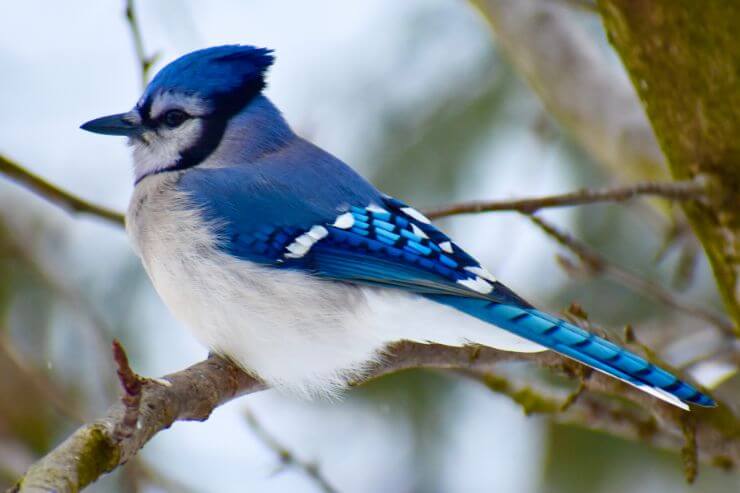
Blue Jays build sturdy nests in the crooks of trees, usually ten to twenty-five feet up where they feel safe. Both the male and female gather sticks, moss, and bits of paper or string to weave a deep, bowl-shaped structure. The female does most of the actual building while the male brings materials. They line the nest with fine roots and sometimes even mud. Blue Jays can be quite protective, scolding anyone who comes too close to their nest.
Blue Jays are known for their varied diet and opportunistic feeding habits. They love acorns, which they sometimes bury for later, but also eat seeds, nuts, and grains. Insects like beetles and caterpillars are important in summer. They have been seen raiding other birds’ nests for eggs or nestlings, though this is not their main food source. Suet feeders and peanuts also attract them in winter. Their bold nature makes them frequent visitors to backyard feeders.
Blue Jays have remained widespread and stable in their numbers over the decades. Their adaptability to human environments has helped them thrive. Conservation efforts have mostly focused on protecting forest habitats where they breed. Historically, some people disliked their loud calls and nest-robbing habits, but today they’re appreciated for their intelligence and bright plumage. They have not required intensive conservation work, though preserving large trees remains important to support their nesting and foraging needs.
3. American Robin
- Scientific name: Turdus migratorius
- Life span: 2-3 years
- Size: 9–11 in (23–28 cm)
- Weight: 2.7-3.0 oz (77-85g)
- Wingspan: 12–16 in (31–40 cm)
- Status: Least Concern
- State status: Migratory and common
- Migratory behaviour: Many leave in fall; return early spring.
The American Robin is widespread across North America, breeding throughout Canada and the United States and wintering as far south as Mexico and Central America. Recognized by their warm reddish-orange breast and gray-brown back, robins have white markings around the eyes and a yellow bill.
Their upright stance and confident movements are characteristic as they search lawns and fields. In flight, you’ll often notice a white patch under the tail. Robins are one of the earliest signs of spring in many areas.
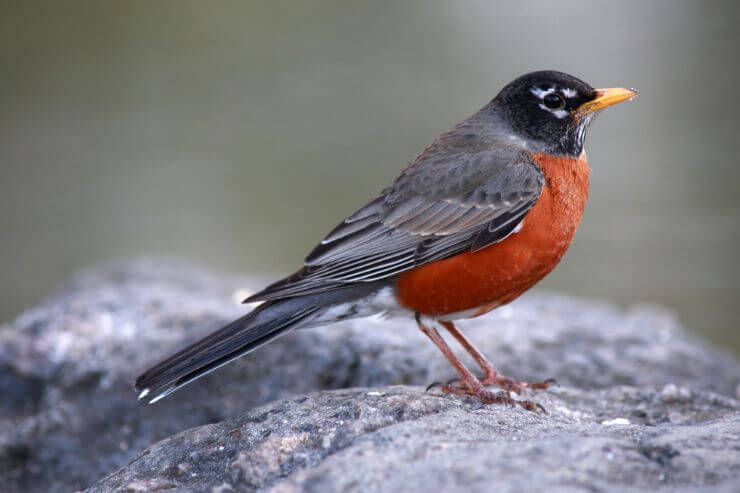
American Robins build open cup nests, usually tucked into tree branches or ledges on buildings. The female carefully shapes the nest from grasses and twigs, then uses mud to strengthen it. She lines the inside with soft grasses for comfort. Robins often raise two or three broods each year, starting early in spring. The turquoise-blue eggs are easy to spot, and the parents stay busy carrying insects back and forth to feed their hungry chicks.
Robins are famous for tugging earthworms out of lawns, especially in the morning when the ground is damp. They also eat insects like beetles and caterpillars. In fall and winter, they switch to berries and fruits, including juniper, dogwood, and crabapple. Their diet shifts with the seasons, helping them survive when insects are scarce. This flexibility allows them to remain active year-round in many areas, moving in flocks to find reliable food sources.
American Robins are one of the most familiar birds across North America. Their numbers remain strong, partly because they adapt well to human landscapes. They were once hunted for food, but legal protections ended that practice long ago. Today, robins benefit from suburban lawns and gardens where worms and fruit are plentiful. Pesticide use can pose threats, so conservationists encourage safer practices. Overall, robins have needed little special protection thanks to their resilience and widespread habitat.
4. Mourning Dove
- Scientific name: Zenaida macroura
- Life span: 2–5 years
- Size: 9–13 in / 23–33 cm
- Weight: 4–6 oz / 112–170 g
- Wingspan: 17–18 in / 43–46
- Status: Least Concern
- State status: Breeding and common
- Migratory behaviour: Partial migrant; some leave in late fall.
Mourning Doves are found across most of North America, including the continental United States, southern Canada, and into Mexico. Their plumage is soft brown and beige with subtle black spots on the wings.
They have a small, delicate head and a long, tapered tail edged in white. A faint blush can appear on the chest, and the wings flash with light tones when they take off. Known for their gentle cooing, they are commonly seen perched on wires or foraging on the ground.
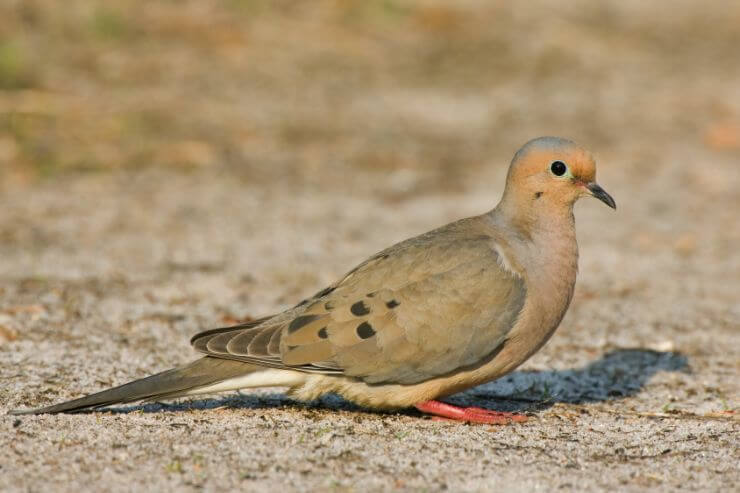
Mourning Doves build rather flimsy nests, often just loose platforms of twigs balanced in trees or shrubs. Sometimes, they nest on ledges or even hanging planters. The female lays two white eggs, and both parents share incubation duties. Their calm nature extends to nesting, if disturbed, they often slip away quietly. Mourning Doves can raise several broods in a season, with new eggs laid as soon as the previous young fledge. Their gentle cooing often signals nesting activity nearby.
These doves mostly eat seeds, which they gather on the ground or at platform feeders. They prefer grass seeds, grains, and sunflower seeds. Mourning Doves swallow seeds whole, storing them in a specialized crop before digesting them later. They also pick up grit or small gravel to help grind the food. Unlike many birds, they drink by immersing their bills and sucking in water, rather than tipping their heads back. This diet supports their high breeding productivity.
Mourning Doves are abundant throughout North America and are among the most commonly hunted game birds. Despite hunting pressure, their populations remain strong due to their prolific breeding. Regulations limit harvest levels to protect them from decline. They’ve adapted well to farmland and suburban environments. In some regions, local efforts encourage planting native seed plants that benefit doves and other wildlife. Their familiar calls and graceful flight continue to make them a welcome sight across their range.
5. American Goldfinch
- Scientific name: Spinus tristis
- Life span: 3-6 years
- Size: 4.3–5.1 in (11–13 cm)
- Weight: 0.39–0.71 oz (11–20 g)
- Wingspan: 7.5–8.7 in (19–22 cm)
- Status: Least Concern
- State status: Migratory and common
- Migration pattern: Some migrate south in late fall.
American Goldfinches are widespread across southern Canada and most of the United States, especially common in weedy fields, gardens, and roadside edges. In summer, males show bright yellow bodies with a striking black forehead and contrasting black wings marked with white bars. Females are more muted, wearing olive and dull yellow tones. In winter, both sexes take on pale, brownish colors. They are agile fliers, often traveling in small flocks that call softly while moving between patches of vegetation.
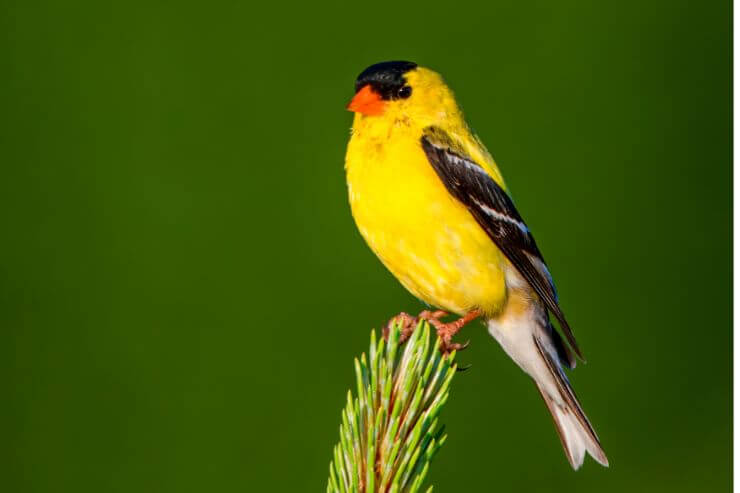
American Goldfinches nest later than most songbirds, usually waiting until mid-summer when thistle and milkweed seeds are plentiful. They build neat cup nests in shrubs or small trees, often five to ten feet high. The female weaves plant fibers and lines the nest with soft down. While she incubates the pale blue eggs, the male brings her food. Goldfinches are attentive parents, carefully feeding the chicks regurgitated seeds until they are ready to fledge.
Goldfinches primarily eat seeds, especially from sunflowers, thistle, and dandelions. They have a strong preference for small, oily seeds, which they crack open with their conical beaks. Unlike many songbirds, they rely very little on insects. This vegetarian diet even influences their late nesting, as they wait for seeds to ripen. At feeders, they’re fond of nyjer (thistle) seed and will cling acrobatically to mesh socks or small perches to extract each seed.
American Goldfinches have benefited from backyard feeding and the spread of weedy fields. They remain common and widespread across their range. Conservation work has mostly focused on preserving native grasslands and discouraging pesticide use that can reduce seed-producing plants. Their populations are stable, and they are not considered threatened. Because they are so adaptable, goldfinches thrive in both rural and suburban settings, where their bright plumage and cheerful calls add color to the landscape.
6. Song Sparrow
- Scientific name: Melospiza melodia
- Life span: 2-7 years
- Size: 5.5-7 in / 14-18 cm
- Weight: 0.8-1.4 oz / 22-40 g
- Wingspan: 9.1-9.8 in / 23-25 cm
- Status: Least Concern
- State status: Migratory and common
- Migratory behaviour: Many migrate south by October.
The Song Sparrow ranges across nearly all of North America, from Alaska and Canada to the southern United States and parts of Mexico. These sparrows have streaky brown plumage with a grayish face and a distinctive dark spot in the center of the chest. Their patterned feathers help them blend into brush and grassy edges. When singing, they perch in plain view, delivering a rich, varied song. They adapt well to different habitats, including marshes, gardens, and shrubby roadsides.
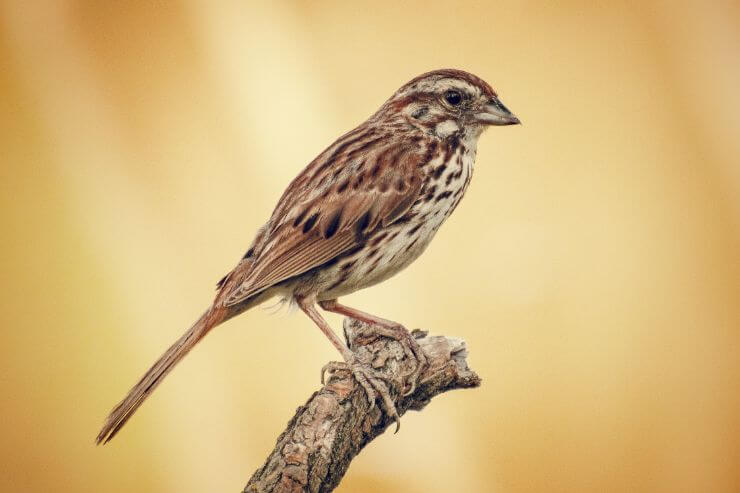
Song Sparrows build cup-shaped nests low to the ground, often hidden in dense grass or shrubs. The female does most of the construction, weaving grass, leaves, and bark into a secure cradle. She lines the nest with softer materials for insulation. Depending on the region, they may have up to four broods per season. The male stands guard nearby, singing persistently to mark the territory and discourage intruders while the female tends to the eggs.
These sparrows eat a mix of seeds and insects, adjusting their diet depending on the season. In spring and summer, they forage for beetles, caterpillars, and spiders to feed their growing chicks. During fall and winter, they shift to grass and weed seeds. They spend a lot of time scratching in leaf litter or hopping along the ground in search of food. At feeders, they will take millet and cracked corn, especially in colder weather.
Song Sparrows are widespread and among the most numerous native sparrows in North America. Their adaptability has helped them remain secure, even as some other species have declined. Habitat loss can still impact local populations, especially in wetlands. Conservationists emphasize preserving native plant communities and wetlands to support healthy breeding grounds. Their populations have remained stable, thanks to their flexibility in choosing habitats and their resilience in the face of moderate environmental changes.
7. European Starling
- Scientific name: Sturnus vulgaris
- Life span: 2-3 years
- Size: 7.5–9 in (19–23 cm)
- Weight: 2.1–3.4 oz (60–96 g)
- Wingspan: 12–17 in (31–44 cm)
- Status: Least Concern
- State status: Breeding and common
- Migratory behaviour: Remains in Ohio all year.
Originally native to Europe and western Asia, the European Starling is now firmly established across most of North America. These birds have glossy black plumage that shimmers with purple and green iridescence in good light. In winter, they take on a speckled appearance with white spots sprinkled over their bodies. Their short tail and pointed wings give them a distinct silhouette in flight. Starlings often gather in large flocks, moving together with impressive coordination in open fields and towns.

European Starlings nest in cavities, including old woodpecker holes, building crevices, and nest boxes. They fill the space with grass, feathers, and sometimes trash. The female does most of the arranging, while the male gathers materials. They can be aggressive, sometimes evicting native species from nesting sites. The pale blue eggs are incubated by both parents. Starlings may raise two broods a season, taking advantage of abundant food sources in cities and agricultural areas.
Starlings have an extremely varied diet that changes through the year. Insects, including beetles and grasshoppers, are favored during breeding season. The rest of the year, they eat grains, seeds, and fruit. They often forage in large flocks, walking across fields or lawns in tight groups. In winter, they visit feeders, sometimes overwhelming other birds. Their strong, pointed bills help them probe the ground or peck at fruit, making them highly adaptable foragers.
European Starlings were introduced to North America in the late 1800s by a group hoping to bring all birds mentioned in Shakespeare’s works to America. Since then, their population has exploded. Because they compete with native cavity-nesters, starlings are considered invasive. Management efforts have included nest box modifications to exclude them and targeted removal in sensitive areas. Despite this, they remain widespread and common across the continent, particularly in urban and agricultural landscapes.
8. Downy Woodpecker
- Scientific name: Picoides pubescens
- Life span: 2-5 years
- Size: 6-7 inches
- Weight: 1 oz
- Wingspan: 13 inches
- Status: Least concern
- State status: Breeding and common
- Migratory behaviour: Present year-round; does not leave.
The Downy Woodpecker is widespread across most of the United States and southern Canada, found in woodlands, parks, and suburban yards. It has a crisp black-and-white pattern, with broad white stripes on the back and black wings dotted with white spots. Males show a small red patch at the back of the head, while females lack this mark. Their straight posture while climbing tree trunks and their short, chisel-like bill make them recognizable among other small birds.

Downy Woodpeckers excavate their own nest cavities in dead or decaying trees. Both the male and female take turns chiseling a hole several inches deep, with a small entrance to keep predators out. They don’t add any nesting material; the eggs rest directly on wood chips left behind from excavation. Once the female lays the eggs, both parents share incubation and feeding duties. The young stay in the cavity until they are ready to fledge.
These woodpeckers eat mostly insects, especially beetle larvae and ants they extract by probing and hammering tree bark. In winter, they also consume seeds and suet, which is why they visit backyard feeders. Their short, chisel-like bill and barbed tongue help them reach hidden insects. They often cling to tree trunks and branches, tapping methodically as they search for food. Their diet helps control insect populations, making them beneficial residents in forests and neighborhoods.
Downy Woodpeckers have remained stable across North America and are common in both natural forests and suburban areas. Conservation efforts focus on preserving standing dead trees and snags, which are essential for nesting. Because they adapt well to human presence, they have not faced significant declines. Maintaining healthy woodland habitats with mature trees ensures their continued success. Bird-friendly forestry practices and leaving dead trees standing help support their breeding and feeding needs.
9. Red-winged Blackbird
- Scientific name: Agelaius phoeniceus
- Life span: 2-3 years
- Size: 6.7-9.1 in (17-23 cm)
- Weight: 1.1–2.7 oz (32–77 g)
- Wingspan: 12–16 in (30–40 cm)
- Status: Least Concern
- State status: Migratory and common
- Migratory behaviour: Most leave by October; return March.
Red-winged Blackbirds are among the most common birds in North America, inhabiting marshes, wetlands, and open fields from Alaska and Canada south into Mexico. Males are jet black with bright red shoulder patches bordered by yellow, which they display prominently when singing.
Females look quite different, streaked brown and heavily marked to blend into reeds and grasses. These birds are known for their loud, musical calls and dramatic displays, especially during breeding season when males defend territories vigorously.
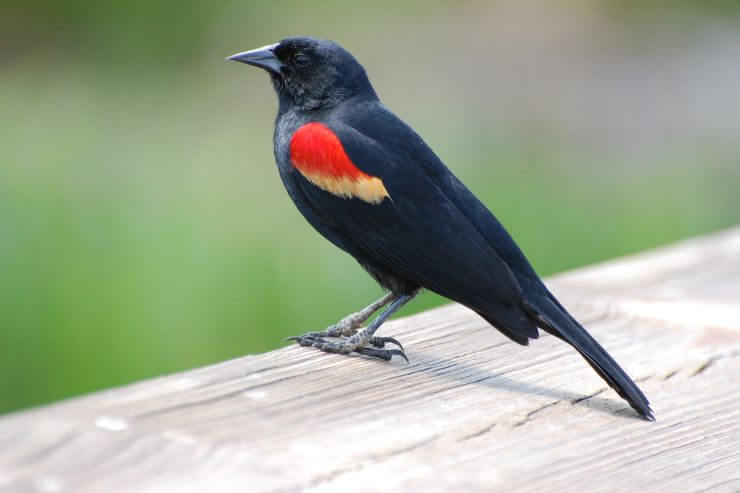
Red-winged Blackbirds build their nests low among cattails or tall grasses in wetlands and marshes. The female weaves a cup from reeds and grasses, anchoring it securely to stems above the water. She lines it with fine plant material before laying her eggs. Males are highly territorial, often perching nearby to display their red shoulder patches and sing loudly. Females care for the eggs and nestlings mostly on their own, returning frequently to feed them.
Their diet changes with the seasons, balancing plant and animal foods. In spring and summer, they eat insects like dragonflies, caterpillars, and beetles. During fall and winter, they switch to seeds and grains, especially from grasses and agricultural fields. They forage in flocks, often combining with other blackbird species. Their strong bills are useful for prying seeds from husks or snatching insects. This adaptable diet helps them thrive in many habitats across their range.
Red-winged Blackbirds are among the most abundant birds in North America. They have benefited from agricultural development that provides grain and seed sources. Large flocks can sometimes cause crop damage, leading to control measures. Despite these conflicts, their populations remain robust. Conservation focuses mainly on preserving wetland breeding habitats, which are vital for nesting. They are considered a species of least concern, and their familiar presence remains a lively part of wetlands and farmlands alike.
10. House Finch
- Scientific name: Haemorhous mexicanus
- Life span: 7-9 years
- Size: 5.1–5.9 in (13–15 cm)
- Weight: 0.59–0.88 oz (17–25 g)
- Wingspan: 7.9–9.8 in (20–25 cm)
- Status: Least Concern
- State status: Breeding and common
- Migration pattern: Stays in Ohio all year.
House Finches are now widespread across most of the United States and southern Canada, thriving in cities, suburbs, and rural areas alike. Males have rosy red coloring on the forehead, throat, and chest, blending into brown-streaked backs and wings. Females lack red and are brown with blurry streaks. Both have slightly curved bills and long, flat heads. Originally native to the Southwest, House Finches spread rapidly after being introduced to the East Coast in the 20th century.
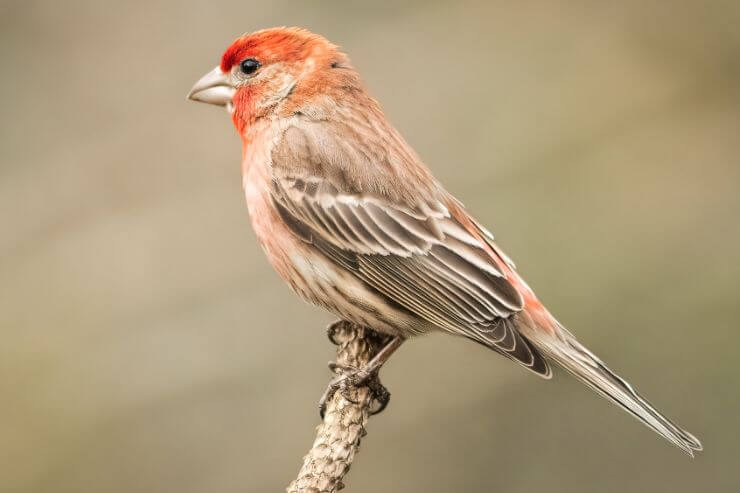
House Finches often nest on ledges, in hanging planters, or on building beams. They build open cup nests from twigs, grasses, and feathers. The female does most of the construction while the male brings materials. Once she lays the eggs, she incubates them while the male brings her food. House Finches frequently reuse the same site year after year. They can raise multiple broods in a season, making them prolific breeders in both urban and rural settings.
These finches mainly eat seeds and fruits. Sunflower seeds are a particular favorite, and they eagerly visit feeders stocked with them. They also consume buds, berries, and occasionally insects. Their short, thick beaks help them crack open hard seeds with ease. In late summer, they often forage in flocks, moving through gardens and fields. This flexible diet supports their success in a wide range of habitats, including city neighborhoods, where they are familiar visitors.
House Finches were originally native to the southwestern United States and Mexico. Released in New York in the 1940s, they quickly spread across the eastern states. Their populations have remained strong, though they were affected by an eye disease called Mycoplasmal conjunctivitis in the 1990s. Conservationists monitor this disease, which can cause temporary declines. Despite occasional outbreaks, House Finches remain abundant. Their adaptability and frequent use of human structures have made them one of North America’s most successful finch species.
Where to Look for Birds in Ohio?
Finding birds in Ohio is pretty easy, and you don’t have to travel far to enjoy it. Many birds love suburban yards, city parks, and country fields. The key is to slow down, look carefully, and listen. Early mornings are often the best time to head out, since that’s when birds are most active. Bring a pair of binoculars and a field guide or bird ID app to help you recognize species by sight and sound.
Some great spots to explore include Magee Marsh Wildlife Area near Lake Erie, famous for spring migrations and warblers. The Cuyahoga Valley National Park offers miles of trails where you can spot woodpeckers, blue jays, and song sparrows. In central Ohio, Blendon Woods Metro Park has bird blinds overlooking feeders and ponds. Finally, Oak Openings Preserve near Toledo is perfect for seeing red-winged blackbirds and goldfinches among the open meadows and forests.
No matter where you go, remember to be patient. Birds often reveal themselves only after you’ve spent a few quiet minutes watching. With a little practice, you’ll start to notice more species and understand their habits, making each outing feel like a small discovery.
Conclusion
Ohio’s diverse landscapes are home to an incredible variety of familiar birds, from bright cardinals to lively chickadees. Whether you’re watching a robin hunt for worms or hearing a woodpecker tapping high in a tree, these everyday encounters bring nature closer to home. By learning to recognize and appreciate common species, we deepen our connection to the world just outside our windows. Keep exploring, there’s always something new to discover in Ohio’s vibrant birdlife.

